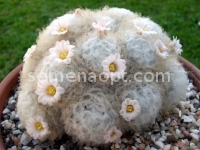
-
- Notice
- No new notifications
-
- Messages
- See all notifications
-
18
- The cart
In the basket 0
in the amount of 0 RUB
- Go to basket
Vegetable seeds Flower seeds Grapes (plants) Mushrooms Agrochemicals
|

|
|
  
|
Motherland - Mexico (Coahuila, on the rocks from Saltillo to Monterey) . Stem round, up to 7 cm in diameter . light green, bushy forms turf, soft nipples, cylindrical ; aksily with white wool; radial spikes to 40, a length of 3 - 7 mm, they are soft, white, feathery, no central spines, flowers length1.5 cm, 1.4 cm in diameter, white, green shed, on the petals dark stripe; reddish fruits . Rhode Mamillaria Haw . - Mammillaria - the most numerous genus of the family Cactaceae . It has 350 species and 98 varieties . Rod is divided into 3 sections hydor-hilum - with watery juice, galaktos-chylos - with milky juice and sub hydro -chymos, whose milky juicethere is only a central vessels . Depending on the shape of the nipples, studs, and the stem, and flowers and other quantities, these attributes are divided into more sections na sub groups and subgroups. Appearance Mammillaria, their flowers, thorns and pubescence unusually varied . A distinctive feature of the genus is the lack of ribs instead of which stemPlants covered with papillae, and the special structure of the areola: it is divided into two parts - one carrying the spikes, is at the end of the papilla, the other - and vegetative - is in aksile (the depression between the papillae) . The flowers appear from last year's axilla around the top . After flowering, the fruit is formed immediately, it gradually emerges from theaxilla . Plant of the genus Mammillaria culture mostly unpretentious . In the summer they need moisture and the sun (with shading from strong heat), in the winter - cold and dry content at + 8, + 10 ° . Some authors (Pazhout, etc. . . ) Identify groups Mammillaria the general background that creates a coating of stem pubescence . Very beautiful white(M . Bocasana, M . Kandnda, M . Plumosa and M . Hahniana) and yellow Mammillaria (M . Elongata, especially the kind of Stella-aurate, M . Pringles, M . tselziana and others), pubescence which hairs, spines and bristles often completely covers the buds on the stem and looks very impressive. White Mammillaria grow in the mountainous regions of Central andNorthern Mexico on limestone and chalk cliffs . They no other cacti need light and sun and requires the addition of lime to the soil . ,
| SPECIFICATIONS | |
|---|---|
| Description | |
| In room culture | cultivated mostly unpretentious |
| It is typical for him | more than any other cacti needthe light and the sun and require supplements to the soil lime |
| Grows | white Mamillaria grow in the mountainous regions of Central and Northern Mexico on limestone and chalk cliffs |
| Features | summer they need moisture and the sun (with shading from strong heat), in the winter - dry and cold content at + 8, + 10 ° |
| Motherland | Mexico (Coahuila, on the rocks from Saltillo to Monterey) |
| Rod | Mamillaria Haw . , Has 350 species and 98 varieties , |
| Flowers | |
| Color | white, green shed, on the petals dark strip |
| Diameter | 1.5 cm long, 1.4 cm in diameter , |
| Features | the last year of the axilla appear around the top |
| Fruits | |
| Color | reddish |
| Features | after flowering fruit is not formedimmediately, he gradually emerges from aksily |
| Spikes | |
| Per stem | radial spikes to 40, a length of 3 - 7 mm, they are soft, white, feathery |
| Features | no central spines |
| Trunk | |
| Diameter | 7 cm |
| Areola | it is divided into two parts - one carrying the spikes, is at the end of the papilla, the other - and vegetative - located in the axilla |
| Form | all forms turf, nipples soft, cylindrical, aksily with white fur |
| Color | light green |
| Branching | bushy |
acanthocalycium backbg .
aporocactus lem
astrophytum lem .
austrocylindropuntia backbg
aylostera speg .
brasilicactus backbg .
brasiliopuntia (k . sch . ) berg .
cephalocerciis pfeiff .
cereus mill .
cleistocactus lem .
cliamaecereus br . et r .
copiapoa br . et r .
coryphantha (eng . ) lem .
dolichothele (k . sch . ) br . et r
echinocactus lk . et o .
echinocereus eng .
echinofossulocactus lawr .
echinopsis zucc .
epiphiliopsis berg .
epiphillum haw .
eriocactiis backbg .
eriocereus (berg . ) ricc .
espostoa br . et r .
ferocactus br . et r .
frailea br . ef r .
gymnocaclus backbg .
gymnocalycium pfeiff .
hamatocactus br . et r
hatiora br . et r .
helianthocereus backbg .
heliocereus (berg . ) br . et r .
horridocactus backbg .
hylocereus br . et r .
lepismium
lobivia br . et r .
loxanthocereus backbg .
mammillaria haw
matucana br . et r .
mila br . et r .
myrtillocactus cons .
neochilenia backbg .
neoporteria br . et r .
notocactus (k . sch . ) berg .
opuntia (tournef . ) mill .
oreocereus (berg . ) ricc .
parodla speg .
peireskia (plum . )
peireskiopsis br . et r
pseudolobivia backbg .
rebutia k . sch .
rhipsalis gartn .
selenicereus (berg . ) br . et r
tephrocactus lem .
trichocereus (berg . ) ricc .
weingartia word .
zygocactus k . sch .
Enter your information
To recover the password
Forgot password? Enter your e-mail
Registration for new users
Enter your details: